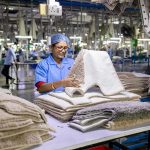Like choosing the right tool for a job, picking between tight and loose knit fabrics comes down to how well they handle moisture. You might assume tighter weaves hold up better, but when it comes to wicking sweat away, the story isn’t so straightforward. Understanding the subtle differences in fabric structure can change how you approach your next garment choice—and it might surprise you which one actually keeps you drier.
Table of Contents
Key Takeaways
- Loose knit fabrics wick moisture better due to open loops allowing faster airflow and evaporation.
- Tight knits enhance moisture movement via capillary action but may trap moisture longer due to density.
- Yarn material influences wicking; polyester in loose knits improves drying, while cotton in tight knits retains moisture.
- Breathability in loose knits supports more efficient moisture transport and cooling during activity.
- For active or warm conditions, loose knits generally provide superior wicking compared to tight knits.
Understanding the Structure of Tight and Loose Knit Fabrics
The structure of knit fabrics plays an essential role in how they perform, especially when it comes to wicking moisture.
Knit fabric structure critically influences moisture-wicking performance and overall comfort.
When you examine knit construction, you’ll notice that tight knit fabrics have closely packed loops, creating a denser fabric texture. This density limits air movement but can enhance moisture movement through capillary action along the fibers.
On the other hand, loose knit fabrics feature more open loops, resulting in a breezier texture that allows air to circulate more freely. This openness can help evaporate moisture quickly but mightn’t pull sweat away from your skin as efficiently.
Understanding these structural differences helps you choose the right fabric based on your needs, whether you prioritize quick drying or better moisture transport.
Impact of Fabric Density on Moisture Wicking
Although fabric density might seem like a simple characteristic, it greatly influences how well a garment wicks moisture.
When you choose between tight or loose knit fabrics, the density affects moisture absorption and fabric thickness, which directly impact comfort and drying speed.
A denser fabric often means thicker material, slowing moisture evaporation, while a looser knit allows quicker airflow but may absorb less moisture initially.
Consider this impact when selecting your garment:
- Higher fabric density usually increases fabric thickness
- Tight knits can trap moisture longer
- Loose knits promote faster drying
- Moisture absorption varies with knit tightness
- Air circulation improves wicking in looser fabrics
Understanding these factors helps you pick the right fabric for effective moisture management.
Role of Yarn Material in Wicking Performance
Since yarn material directly affects how a fabric handles moisture, you’ll want to contemplate its properties carefully when choosing wicking performance.
Different yarn types, like cotton, polyester, or wool, vary greatly in moisture absorption. Cotton, for example, soaks up water quickly but holds onto it, which can leave you feeling damp.
Polyester, on the other hand, repels moisture and moves sweat away from your skin faster, enhancing drying time.
Wool naturally wicks moisture while maintaining warmth, making it ideal for varying conditions.
When selecting fabric for wicking, consider how each yarn type manages moisture absorption and release. Choosing the right yarn material guarantees your garment performs effectively, keeping you dry and comfortable during activity.
Understanding these differences helps you pick fabrics tailored to your needs.
Breathability and Airflow Differences Between Knit Types
When you choose between tight and loose knit fabrics, you’ll notice a significant difference in how air moves through them. Loose knits naturally allow more airflow, enhancing breathability, while tight knits restrict it. This impacts how well breathable fibers perform, affecting moisture management and comfort.
Understanding the airflow dynamics helps you pick the right fabric for your needs.
Consider these key points about breathability and airflow differences:
- Loose knits create larger gaps for air to circulate freely
- Tight knits limit airflow, trapping heat and moisture
- Breathable fibers work best with fabrics that allow air movement
- Airflow dynamics affect drying speed and cooling efficiency
- Your activity level influences which knit structure suits you
Choosing the right knit impacts how fresh and dry you feel.
Practical Considerations for Choosing Knit Fabrics Based on Wicking Needs
Understanding how knit structure affects airflow sets the stage for making smart choices about fabric wicking. When selecting fabrics for specific applications, consider how tight or loose knits influence moisture management.
Loose knits allow better airflow and quicker drying, ideal for activewear or casual summer clothing where breathability matters. Tight knits, while less breathable, can trap moisture longer but offer more durability and warmth, suited for colder weather or layering pieces.
You should also think about the activity level and environment where the fabric will be used. For intense workouts, loose knits with enhanced wicking properties keep you dry and comfortable.
For moderate use or fashion-focused fabric applications, a tighter knit might balance appearance and function. Knowing these practical factors helps you pick the right fabric that meets your moisture management needs precisely.
Frequently Asked Questions
How Does Fabric Stretch Affect Moisture Wicking in Knit Fabrics?
Imagine your fabric stretching like a spring, pulling moisture away from your skin. When you use fabric elasticity, you boost moisture transfer, keeping you dry and comfortable even as you move and sweat during your activities.
Can Spandex Addition Improve Wicking and Fabric Recovery?
You’ll find spandex benefits include enhanced recovery properties, letting your fabric stretch and snap back quickly. While it doesn’t directly boost wicking, it helps maintain fabric fit and comfort during activity, improving overall performance.
Do Knit Fabrics Lose Their Wicking Ability Over Time?
Think of fabric aging like a candle’s wick—over time, its flame dims. You’ll notice wicking efficiency drops as fibers wear, but with proper care, your knit fabric can keep pulling moisture like a thirsty plant in spring.
How Does Yarn Thickness Influence Long-Term Wicking Performance?
You’ll find yarn density impacts long-term wicking since thicker yarns can trap moisture, increasing retention. Thinner yarns usually wick better over time by allowing quicker evaporation, keeping you dry and comfortable during extended wear or activity.
Are Blended Fibers Better Than Pure Synthetics for Wicking?
You’ll find blended fibers often improve moisture management by combining fiber composition strengths. They wick better than pure synthetics alone, balancing breathability and durability, so your gear stays drier and more comfortable during activity.
- Where to Buy an Official Google Pixel 2 Fabric Case in [Current Year - June 25, 2025
- The Best Cotton Fabric for Pillow Cases: Sateen vs. Percale vs. Jersey - June 25, 2025
- What Is a Fabric Pencil Case? a Simple Explainer for Shoppers - June 25, 2025







